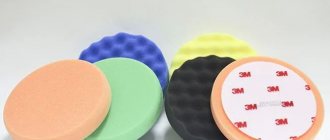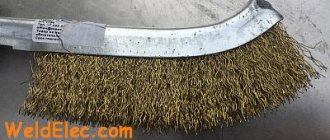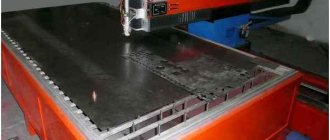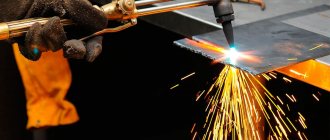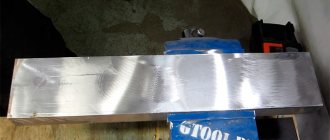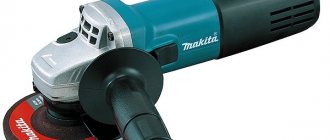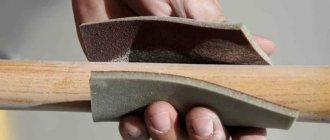Metalwork related to the preparation of metal and wooden surfaces by removing irregularities is carried out using a special tool equipped with a cutting edge. Scraping, or grinding, contains different technologies for finishing workpieces for parts; the operation is carried out both directly with devices and with the use of abrasives of different grain sizes. All working processes allow you to obtain a workpiece with a perfectly smooth surface; scrapers for metal and wood help create tight adhesion to other parts.
What is a scraper?
A tool designed to remove a thin layer of metal from the surface of a workpiece, used to remove the surface film before soldering or welding elements of a loaded structure, as well as before assembling parts of precision instruments.
Using the scraping method, the sharp edge of a metal scraper blade removes the top layer of material 0.01 mm thick. Metal scraping is also used when sanding wood after processing with other tools. During the cleaning process, the surface is checked with a surface plate covered with a layer of paint. The presence of irregularities is revealed by painting individual sections of the workpiece, which are removed by repeated scraping of the problem area.
Metalwork scrapers differ:
- A shape that can be flat, shaped, multifaceted
- A design that contains replaceable plates
- Number of grinding edges: one-sided, two-sided and three-sided.
In terms of design, the device can be collapsible or integral.
What is scraping, where and for what purpose is it performed?
Among all processing procedures, scraping is used in 25% of cases. Its main advantage over lighter abrasive-grinding work is the preservation of greater wear resistance and extended service life. Also, such a top layer is the most prepared for preserving lubricant, since shallower fragments alternate with depressions. The degree of roughness is achieved in two stages:
- preparatory – cut to 0.03 mm;
- final – up to 0.08 mm.
The technology is used in mechanical engineering of any complexity, as well as in the manufacture of spare parts and assemblies. It is carried out in factories, and only part of the work can be performed automatically (large planes), the rest is performed manually by a scraper.
Metal stripping tool
A metalwork scraper is made of a standard length, the width of the blade depends on the type of operation: for roughing, a tool with a blade width of up to 3.0 cm is used, finishing cleaning is carried out with a cutting part 2.0 cm wide. The technology is selected depending on the sharpening angle of the blade, which is designed for each type of operation:
- 750-900 - roughing;
- 900 - finishing operation;
- 900-1000 - finishing cleaning.
The sharpening angle of the tool blade is measured relative to the axis of the product handle.
Technical characteristics of the device
The term “scraping” itself appeared in our country from Germany. Translated, it means “scraping,” which fully corresponds to the essence of the operation. With this treatment, all sorts of defects are scraped off the metal surface, which makes it very smooth.
The scrapers used for this procedure are made of tool steel alloys. Their design includes a cutting element and a handle, which can have a three- or tetrahedral shape. To impart high hardness to the working element of the pusher, it is subjected to special heat treatment.
In most cases, instruments have a standard length of twenty to forty centimeters. The width of the cutting element depends on the type of processing and the task at hand. For example, black scraping of production with a tool with a working part width of 15 to 30. The finishing procedure assumes a width of 15 to 20 millimeters.
The sharpening angle of the tool tip also depends on the type of scraping . Experienced locksmiths recommend using the following angles:
- from 90 to 100 degrees - for finishing operations;
- 90 degrees - for finishing (scraping);
- from 75 to 90 - for black scraping.
You should also remember that the sharpening angle must be measured relative to the axis of the tool.
The geometric characteristics of a scraper are not determined by GOSTs, although some inexperienced craftsmen are trying to find such information in the 1465−80 standard, which does not concern scrapers at all, since it regulates the parameters of files.
Surface paint
After completing the preparation of the material, residual irregularities are identified by applying a painted control plate. Scraping paint is made from pigment mixed with any type of industrial oil. The pigment used is azure, blue, red lead or a mixture of soot, autol and kerosene. The scouring paint should have the consistency of a medium thick paste, not spread or form lumps. The mixture should lie on the plane of the control plate in a thin, even layer.
Conclusion
At the end of the review, it can be noted that double-sided models made of alloy or medical steel are still more popular among the population. Also leading positions are occupied by German and domestic brands (the latter are considered more affordable). And since by 2022 the fashion for beautiful and simply well-groomed nails is gaining momentum, professional devices and their budget analogues are in increasing demand. And if expensive options are desired for salon procedures, mostly made from high-alloy steel. Practical and inexpensive models are quite suitable for use in everyday life. Despite this, everyone’s requirements for the device are deeply individual, and their financial capabilities are different. And it’s up to you to decide which company’s product is better and which model to choose.
Types of metal scrapers
A flat-type device with three edges or a shaped blade is suitable for working with a straight flat surface or sharp corners of a product; it cuts aluminum, copper and bobbit well. The triangular blade tool is used for machining cylindrical type holes in carbide metal workpiece.
When scraping the surface of parts, the tool used, the principle of scraping and grinding at a certain angle, must have replaceable sharpened plates that allow the formation of an angle with respect to a flat surface. Operations are most often carried out with a universal scraper, the design of which contains:
- Frame;
- Pen;
- Holder;
- Clamp screw;
- Replaceable plate.
GOST
State standardization affected scrapers exclusively from the point of view of the rules for accepting this tool and the requirements for metals that can be used in production.
As for the geometric parameters, they are not regulated by GOSTs in any way, however, GOST 1465-80, which applies exclusively to files, is often mistakenly taken for such a standard.
Marking
There is no single marking scheme for scrapers; however, some manufacturers offering tools in sets use color divisions based on the material they are intended to work with.
Typically, handles or their parts (inserts) are painted in the following colors:
- Green – for processing aluminum;
- Red – for cast iron and brass;
- Blue – for steel;
- Yellow – for soft materials, such as plastic.
Separation by color allows the owner to immediately understand the purpose of a particular scraper.
How to scrape correctly
The type of scraping does not involve preparing the surface of the material being processed. The work is carried out in a strict sequence of operations:
- Apply paint to the control plate;
- Place the unpolished part on the plate and smoothly move it back and forth;
- Visually assess painted defects;
- Prepare the tool;
- Proceed to remove irregularities by moving the scraper with a blade angle of 35-400.
Working with a metal surface involves scraping off any bulges. The principle of scraping is to create long segments formed by sliding the blade and then reducing the amplitude. The direction of movement of the tool should change gradually and cross. During work, it is recommended to check the level of smoothing of irregularities with a painted plate or a 25x25 mm test square.
Machines used
The principle of scraping parts makes the tool suitable only for manual work. There are devices that can be called semi-automatic. But the choice of nozzle still remains with the master, as well as the direction and choice of darker and lighter areas of paint. But forward and backward impulse movements are performed automatically, which facilitates and speeds up the work of the mechanic.
Main characteristics of roughing machines
The choice should be made depending on:
- quality of steel - the alloy must contain a large percentage of carbon and alloying additives;
- sharpening angle, because for primary finishing it can be 75 degrees, and for finishing – 90;
- hardness of the processed material;
- blade width;
- edge radius.
Surface testing technique
The control square helps determine the depth of scraping of the surface of a part or workpiece. In the middle of the frame attached to the surface of the part, a control area is selected and the number of painted spots is counted. The type of irregularities can be determined by the number of convexities:
- If the number of spots reaches 6, the scraping is rough;
- If there are up to 10 spots, the scraping is clean;
- When the number of spots is at least 14, the processing is accurate;
- When the number of painted spots is 22, the cleaning is for jewelry.
The operation of leveling the front part of the parts, the tool and the scraping method used depend on the type of surface. To process the edges, a straight-type device is used, the scraper cleans bent parts with a shaped blade, hard materials are processed with a narrow blade, scraping soft materials and flat surfaces is carried out with a wide scraper and a radius-type blade.
The shape of the device’s blade is selected according to the type of surface, which can be identified by rolling the part over a painted plate. Identified irregularities are removed with a device with a long sharpened edge. The types of scrapers used start moving from the edge of the workpiece. After completion of the operation, a control check of the cleanliness of the treatment is carried out, for finishing which the scraper uses a bench tool and a ferrite edge < 1.5 cm.
Pushers for home use
Vigor (19013851)
The products are manufactured in Pakistan. Made from durable stainless steel. It is safe and practical. Can be sterilized. It is in high demand among domestic consumers due to the price-quality ratio. The reviews are only positive. Can be purchased at specialized retail outlets or ordered online in an online store.
Purchase price – 439 rubles.
Vigor (19013851)
Advantages:
- affordable price;
- practicality;
- long service life;
- safety.
Flaws:
- not installed.
Samo.Professional (17911764)
An indispensable accessory for every woman who tries to look well-groomed. The product with a double-sided working surface is made of metal. Allows you to treat cuticles, clean the inner surface of the nail, and remove dirt. The handle is ribbed, which increases the ease of use of the pusher. Doesn't slip out of your hand. Purchased for salons and nail manipulation at home. Country of origin: Korea.
The average cost is 450 rubles.
Samo.Professional (17911764)
Advantages:
- practicality;
- ease of operation;
- suitable for regular use;
- safety;
- value for money.
Flaws:
- none.
Ineira (21680665)
An interesting and practical device for decorating marigolds. Materials of manufacture: plastic and ceramics. The instrument is white. Length – 140 mm, width – 80 mm, height – 80 mm. It weighs little, which allows you to work with it for a long time, without getting tired. Delivered to store shelves in convenient packaging. Suitable for home use.
The average price is 390 rubles.
Ineira (21680665)
Advantages:
- value for money;
- ease of use;
- ease;
- safety.
Flaws:
- none.
Irisk Professionl (14331109)
The pusher is produced by an American company. Double-sided model. Suitable for pedicure and manicure. Thanks to the convenient spatula, you can quickly and efficiently clean your sinuses. Belongs to the category of multifunctional. In production, hardened steel is used. It can be tidied up in any way, including through sterilization. Suitable for home use and as a holiday gift or just like that.
The average cost is 260 rubles.
Irisk Professionl (14331109)
Advantages:
- versatility;
- positive reviews;
- advanced functionality;
- an ideal gift for a woman;
- value for money;
- reliability.
Flaws:
- not found.
Natbro Professional (23135842)
Products made from Japanese steel are in high demand among Russian women. It can safely be classified as professional, although it is purchased mainly for tidying up your fingernails and toenails yourself, without visiting a beauty salon. Length – 132 mm. Makes it possible to painlessly push away the growths and carefully free the nail plate from them. No hooks appear. A device with two working surfaces that differ in parameters and shape. The instrument is manually processed at a professional level.
The products can be purchased at specialized retail outlets at a price of 384 rubles.
Natbro Professional (23135842)
Advantages:
- professional level;
- reliability;
- safety;
- versatility;
- practicality.
Flaws:
- not identified.
Lovely (11583005)
Products from a domestic manufacturer are suitable for everyone who is used to having well-groomed hands without leaving the house. The surface of the handle is corrugated, which prevents the tool from slipping out of your hands. The rounded tip will painlessly and safely push back cuticles. The pointed side will clear away dirt and free the nail plastic from unnecessary growths. Product length – 150 mm, width – 40 mm. The reviews are only positive.
Purchase price – 250 rubles.
Lovely (11583005)
Advantages:
- reasonable cost;
- functionality;
- wear resistance;
- versatility.
Flaws:
- not identified.
Recommendations from a professional scraper
In order for the cutting tool to last a long time and help prepare materials efficiently, it is recommended to pay special attention to the choice of device. All types of scrapers are adapted according to the shape of the cutting edge to perform technological tasks. The best option is to choose universal type equipment, the design of which allows you to quickly replace plates in accordance with the requirements of the technical process.
Due to technical features, different types of scrapers cannot be used on surfaces with large defects and deep scratches. The part must undergo rough processing on a milling machine or other grinding equipment. All surface leveling cycles must end with a test with a control plate containing pigment dye.
Destination Features
The scraper is a universal machine that is widely used in various fields. Plumbing, lithography, sculpture are some of the few areas where specialists use scraping technology. This metal-cutting tool helps to achieve an ideal surface for proper mating of individual parts of an object.
Scrapers occupy a special niche in the toolkit that is needed in the field of metalworking. Using a multifaceted machine, the thinnest layers of metal products are removed, which helps give the object a perfect shape. This operation is widely applicable to various moving parts that act as part of larger mechanisms. The following elements are sharpened using scrapers:
- parts of high-voltage mechanisms;
- parts of automotive products (bearings);
- measuring devices (rulers, compasses and squares);
- building materials (tiles);
- cutting edges for devices.
Scrapers are used when engraving various products; also, with the help of a pointed tip, the master can easily remove layers of dried glue, silicone and other old coating. Nail service technicians are also well acquainted with the scraper - using a small spatula-shaped machine it is easy to process nails during manicure and pedicure.
The design of the tool is determined by its general purpose. The scrapers used in metalworking have their own anatomical structure, and machines designed for processing more pliable materials have a different structure. The shape of the universal scraper is justified by the multidirectionality of the operations performed - such machines are useful in any craft.
Effective scraping methods
Choose a more convenient movement of the blade - away from you or towards you. The first one is easier for beginners, but the second one is more productive since it doesn't require a second pass. Make the movement quickly and with pressure, and return smoothly. In the reverse direction, no removal should occur. To remove paint residues, use a solvent and wipe the surface dry.
How quality is assessed
To check how well the part is processed, it is re-painted with dye. Now you need to estimate the number of dark spots and depressions. To do this, a control frame is installed on the treated area - a square with a side of 25 mm. Now you need to count how many specks are inside:
- up to 5 – low quality or rough draft;
- up to 10 – fine finish, but not the best;
- up to 14 – semi-finish;
- up to 22 – accurate;
- over 22 – delicate work.
Methods and techniques of scraping
When working with a flat straight scraper, the working stroke is forward movement away from the worker (scraping away from you), with a flat scraper with the end bent downwards - movement towards the worker (scraping towards yourself), and with a triangular scraper - lateral movement.
When processing a flat surface away from you, the scraper, held by the handle with your right hand, is set at an angle of 20–30° to the surface (Fig. 12), and with your left hand you press the end of the scraper near the cutting edge and move it forward (working stroke) and backward ( idling). To work with a flat, straight, double-sided scraper, take a strand of rags in the right palm of the hand of such a size that the fingers can close with the thumb, and the scraper blade is rested against this rag in the center of the palm while working, holding it in the working position at an angle of 20–30° to the surface fingers of the right hand. With your left hand you hold the scraper by the rod, by the forend, press it to the surface being processed and direct its movement.
Rice. 12. Techniques for scraping with a flat straight scraper
Self-scraping is performed when finishing precise surfaces. With this method, the scraper is less prone to jamming and scuffing, the surface is cleaner, and it is easier to regulate the pressure. At the end of each working stroke, the scraper is separated from the surface being processed; only under this condition is it possible to obtain a smooth and precise surface. If the scraper remains under the chips at the end of the working stroke, ledges and burrs remain on the processed surface and the surface becomes uneven.
Surface preparation . Before scraping, the workpiece surface must be adjusted in height to the level of the worker’s thigh, leveled in a horizontal plane, it is necessary to ensure that the workpiece is stable to the worker’s efforts (without oscillations or vibrations) and that the workpiece can be walked around from different sides, as well as good illumination of the workpiece surface.
The surface of the product intended for scraping should not have protrusions, since they are very difficult and time-consuming to remove with a scraper.
The scraping allowance should be in the range of 0.1–0.5 mm, depending on the length and width of the surface being processed. The longer and wider the surface, the larger the allowance should be.
If the plane to be scraped has large unevenness or wear reaches 0.5–0.8 mm over a length of 1000 mm, it is pre-processed on a planer, milling or grinding machine or filed with a file. Parts received for scraping must be filed after mechanical processing on machines. At the same time, sharp edges and burrs and high places accessible to the file after the first “paint” check are removed along the contour of the surface being processed.
For filing and scraping bulky parts, a straight edge or a plate with applied paint is placed on the surface to be processed and moved lengthwise and crosswise without pressure; when processing light parts, they are placed on a plate with applied paint and moved lengthwise and crosswise without pressure. The ruler (plate) must be applied and removed in a strictly vertical direction. The surface is considered prepared for scraping if, when a straight edge is applied to it, an even gap of no more than 0.05 mm is formed.
Scraping flat surfaces consists of three transitions:
- preliminary (roughing), in which the most protruding places and risks of previous processing are removed;
- finishing (local), which serves to increase the number of points lying in the same plane;
- final (breaking), in which the protruding places on the scraped surface are finished.
The quality of scraping is checked by counting the number of spots on an area of 25 x 25 mm by placing a square frame on the surface being tested (Fig. 13). The frame is made of thin sheet metal or thin cardboard. The number of spots is taken as the average of several checks on different areas of the treated surface.
Rice. 13. Checking the surface after scraping using a frame: a - frame; b - verification method
Preliminary (rough) scraping . During this operation, the marks and risks of previous machining are first removed with long strokes of the scraper, and the chips are driven at an angle of 35–45° to the direction of these marks.
Cast iron is scraped dry. When scraping steel or other hard metals, soapy water or kerosene is used, into which the scraper is periodically immersed. The length of the working stroke of the scraper is 10–15 mm.
The direction of scraping must be changed so that the strokes of the subsequent scraping are at an angle of 90° to the direction of the strokes of the previous scraping. When the risks of the previous treatment are not visible to the naked eye, a surface plate or ruler, previously coated with a thin layer of paint, is applied to the surface to be treated. Marks of paint (shading) reveal protruding areas of the surface. These places need to be scraped again.
Repeating this scraping pattern will gradually level the surface. Preliminary scraping is completed when the entire surface, when paint is applied to it, is covered with large spots of paint - up to four spots on an area of 25 x 25 mm.
Finish scraping , also called local or point scraping, increases the number of bearing points on the surface being processed.
When finishing scraping, the surface is treated with scrapers no more than 15 mm wide with a working stroke length of 5 to 10 mm. After this operation, the number of spots on the processed surface with an area of 25 x 25 mm should be from 8 to 16. This is achieved by the fact that the cutting depth is less than during roughing and the number of points is increased by cutting off the vertices of the previous processing. This can lead to the merging of individual spots into arrays that will be approximately evenly distributed over the treated surface.
The final scraping (breaking down the spots) consists of dividing all the largest spots into small ones using a short, shallow stroke of the scraper. At the same time, small spots remain untouched.
The scraping process must be carried out so that the surface, approaching the final form, has on average an equal number of spots per square 25 x 25 mm, both in the middle and at the edges. After a series of checks, when the spots are broken down, shiny spots appear on the surface, corresponding to protruding parts, which, when rubbed against the control plate, acquire a metallic sheen. As the surface improves as a result of scraping, simultaneously with the increase in the number of shaded spots, the number of shiny spots also increases, and their size approaches the size of shaded spots. The presence of shiny spots indicates the highest parts of the surface, so when breaking up spots, paint is not as important as when preliminary scraping. But its presence on the control surface is mandatory, since it reduces friction and serves as a lubricant. In addition, on the surface being tested, the paint creates a background against which spots with a metallic sheen can easily be distinguished.
They mainly break up shiny spots, removing them first. The more shiny spots there are on the surface, the more accurate the scraping.
After final scraping, the surface should have from 20 to 25 spots in an area of 25 x 25 mm.
Finishing (decorative) scraping , often called frosting, is performed to improve the appearance of the surface. There is no improvement in accuracy as a result of this operation. It is produced with scrapers with a curved end. Since such a scraper cuts to a depth of 3 microns, the amount of wear can be judged by frost abrasion on the guide planes.
306

